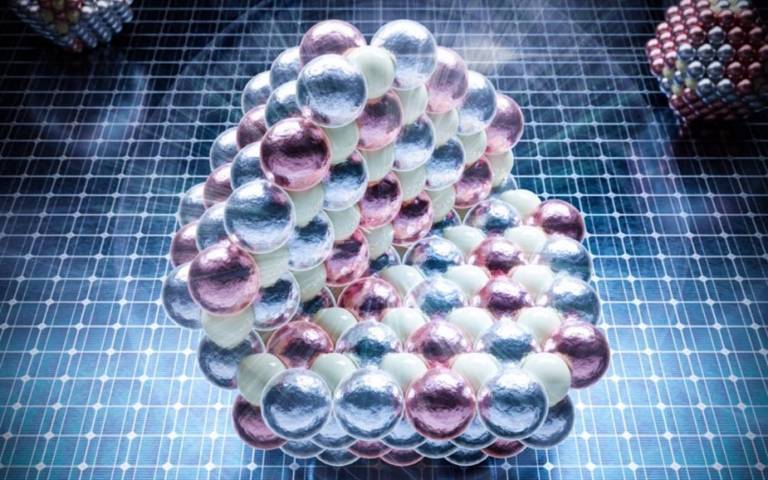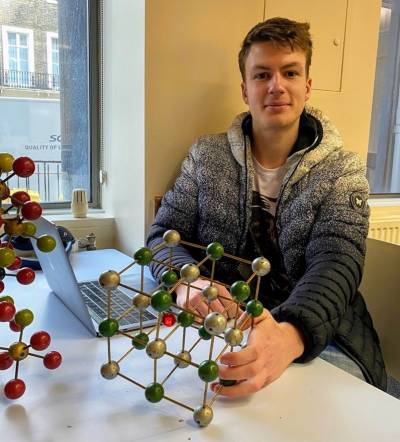New efficiency record set for ultrathin solar cells
15 February 2022
A team co-led by UCL researchers has substantially increased the efficiency of a new type of solar cell, potentially paving the way for its use as a low cost, environmentally friendly alternative to existing solar power technology.

Standard solar cells are silicon-based, but they are bulky, expensive and energy intensive to produce. Current ultrathin alternatives, which can be applied to windows and can generate energy while allowing visible light in, are mainly composed of toxic elements such as lead or cadmium, or contain scarce elements such as indium or tellurium.
In a new study, published in Nature Photonics, the research team investigated how to improve the efficiency of a newer type of solar cell, made from nanocrystals containing two kinds of metal atoms – silver and bismuth.
Using complex computer modelling, researchers at UCL found that an even, 50/50 spread of silver and bismuth atoms across the material increased how much light the nanocrystals absorbed, allowing more energy to be generated.
Colleagues at ICFO in Spain fabricated ultrathin solar cell material (100 nanometres or one 10,000th of a millimetre thick), heating up the nanocrystals to ensure a more even spread of metal spheres, and recorded a power conversion efficiency of more than 9% (that is, more than 9% of the energy input from sunlight was converted into electricity). While this may not seem enormous, the maximum physically-possible solar cell efficiency is 30%, so this is a major result.
Researchers say this level of efficiency could make the technology commercially viable, but that more improvement is needed to make the technology as efficient as silicon-based solar cells.

PhD researcher Seán Kavanagh (UCL Chemistry and Imperial College London), co-first author of the paper, said: “We are thrilled that our computational modelling helped increase the performance of these bismuth-based solar cells to such an extent.”
“The results show how our research, looking at the underlying chemistry and physics of materials, can help in the design of high-performance, low-cost devices and support a green economy.”
“These particular solar cells have made huge leaps in efficiency in less than a decade, from 1-2% to 9%. This gives us confidence that further improvements are possible, and the goal is to further improve efficiency so it is comparable with silicon-based solar cells.”
The calculations were based on quantum mechanical models and required massive computing power – some calculations were performed on more than 10,000 CPUs (central processing units) in a network running simultaneously for 24 hours.
The work was achieved using the UCL Kathleen High Performance Computing Facility (Kathleen@UCL), the Imperial College Research Computing Service, the ARCHER2 UK National Supercomputing Service and the UK Materials and Molecular Modelling (MMM) Hub.
As well as consisting of non-toxic, earth-abundant elements and being cheap to produce, the bismuth-based nanocrystals have proven to be very stable, the researchers say, avoiding degradation of the cell over long periods of time.
The research team note that the solar cell material was 10-50 times thinner than current thin film photovoltaic (PV) technologies and 1,000 times thinner that silicon PV.
Co-author Professor Gerasimos Konstantatos of ICFO said: “The devices reported in this study set a record among low-temperature and solution processed, environmentally friendly inorganic solar cells in terms of stability, form factor and performance. We are thrilled with the results and will continue to proceed in this line of study to exploit the intriguing properties [of the precisely engineered nanocrystals] in photovoltaics as well as other optoelectronic devices.”
The study received support from the EPSRC, the European Research Council, and the European Union’s Horizon 2020 research and innovation programme, among other bodies.
Dr Kedar Pandya, Director for Cross-Council Programmes at EPSRC (Engineering and Physical Sciences Research Council), part of UK Research and Innovation, said: “As we move towards environmentally-friendly, low carbon sources of energy the team’s findings are an important step towards increasing the efficiency of solar power technology.
“And by potentially reducing our dependency on the toxic or rare elements currently needed to produce solar cells, these findings could also deliver further environmental and cost benefits.
“It also demonstrates how the UK’s new supercomputer, ARCHER2, is helping researchers to produce results that could deliver benefits for all of society and the environment.”
Links
- Research paper in Nature Photonics
- Seán Kavanagh’s research profile
- UCL Chemistry
- Mathematical & Physical Sciences
- ICFO
Image
- Top Artist's impression of the record-breaking nanocrystals, with sulfur atoms in yellow and the bismuth and silver atoms in blue and red.
- Middle: UCL & Imperial College researcher Seán Kavanagh with an atomic model of the nanocrystal structure.
Media contact
Mark Greaves
T: +44 (0)7990 675947
E: m.greaves [at] ucl.ac.uk
 Close
Close

